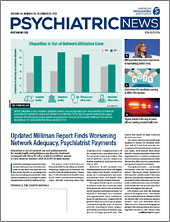Today’s psychiatry residents are facing the same challenges with which their more experienced colleagues have long been wrestling: the serious shortage of psychiatrists, access issues for patients, inadequate parity enforcement, low reimbursements, and more. How is residency helping to prepare trainees for the real world of medicine, and what changes are most needed to support those who will become the future of the profession?
Last month, fifth-year resident Daniel Cho, M.D., M.P.H., sat down with Psychiatric News to answer these questions and more. He is the chief resident of psychiatry and behavioral medicine at Charleston Area Medical Center/West Virginia University-Charleston. He is also president/chair of the APA/APAF Leadership Fellowship and a member of APA’s Board of Trustees and Council on Advocacy and Government Relations.
Q. Right now you’re completing your last year in a five-year dual certification program in psychiatry and internal medicine. How did this come about?
A. I initially went into medical school planning on pursuing internal medicine, but once I did my psychiatry rotation, I fell in love with psychiatry. Whereas most of the individual branches of medicine can extend life, psychiatry is one of the few specialties that can really expand quality of life. For example, treating patients’ diabetes or blood pressure can add years of life, but a patient might be unhappy. In psychiatry, we can treat patients for anxiety or depression, helping them to live the kind of life that they want to live.
Q. Residents have a unique vantage point in the health care system. What do you think is a major area in which psychiatric care can improve? What contributions do you see yourself making?
A. The lack of a collaborative approach between mental and physical health is one of the biggest gaps in our health care system. With aging, patients with psychiatric illness will eventually develop other illnesses, like hypertension or diabetes. But psychiatrists can be reluctant to discuss nonpsych medications. Similarly, primary care doctors have the same reluctance adjusting patient’s psychiatric medications. Not that either needs to manage the other, but a conversation that should take place often doesn’t.
So essentially, an individual is often treated as two different patients in the same body. It’s a huge gap in our system and one that should be bridged. I’d like to see psychiatrists and primary care doctors collaborate on treatment—to partner for the good of their patients. Why shouldn’t we share input on a patient with metabolic syndrome on antipsychotics? Or hypertension on lithium?
I’d like to continue working in academic medicine, helping to train future psychiatrists and influence patient care.
Q. In what way has your residency program best prepared you to become a physician and psychiatrist?
A. When you come out of med school, you may know about medications, disease pathology, and diagnostic criteria, but it’s the art of medicine that you are missing until you get into residency and how to bring that all together.
For example, in psychiatry, the therapeutic alliance with patients is king. What I learned from residency is how to develop that alliance, demonstrate empathy, and gather more information from nonverbal cues. In residency, I also learned about professionalism and systems-based practice, or how we as physicians fit into the health care system. It’s not just the medical knowledge—it’s how to be a doctor.
Q. What have been some of the greatest challenges you have faced as a resident?
A. As residents, on any given day we must answer to multiple masters: our patients, our attending physicians, insurance companies, our institutions, the obligations of our personal life. Finding balance is difficult because some of these demands are at direct odds with one another. How does one navigate that?
In a typical day, I may see patients until 6 p.m. or 7 p.m., and then I have to complete documentation and charting. Afterward I may have prior authorizations or other insurance demands like peer-to-peers. There are only so many hours in a day, so something’s got to give. We residents often sacrifice our personal obligations or health, and this is why we have the burnout and well-being crisis that we do.
For psychiatry residents, we also have to carry the difficult things that people tell us, and that can be very saddening, and dealing with a tragedy like suicide is incredibly difficult. We have to try to find a way to process all that and then be ready to start again the next day at 6 a.m. It can often be a Sysyphean struggle.
Furthermore, helping patients improve their mental health can be very drawn out—it’s not like in some specialties like surgery, where the physician performs an operation and the patient is cured. For mental illness, the process to achieve relief can take months to years.
Q. What changes do you think are needed to improve life for psychiatry residents?
A. Residents are at the crossroads of all the different issues that psychiatry is facing: clearly we’re caught in the middle of the psychiatrist shortage, lack of parity for mental health and substance use treatment, and access issues for patients.
For example, because reimbursement for mental health treatment is not adequate, many psychiatrists don’t accept Medicare, Medicaid, or even private insurance. That means we frequently handle the care of people who are seriously mentally ill and destitute. This in turn increases the caseload for residency clinics and impairs residents’ work-life balance.
According to a 2017 report by the Association of American Medical Colleges, 77% of U.S. counties reported a severe deficit of psychiatrists. To help address this, APA is advocating for an increase in federal funding to boost the number of GME [graduate medical education] spots for psychiatrists. For example, the Resident Physician Shortage Reduction Act (S 348/HR 1763) would not only create more GME slots, but also reserve half of them for residency positions in specialties identified as experiencing a shortage. Training more psychiatrists would ease the burden on residents and ultimately allow us to better meet the needs of people with mental illness.
I believe more advocacy training, such as how to fight stigma and advocate for patients and for our profession, is also needed in residency programs. Through my various APA activities, I had the opportunity to learn advocacy and what needs to happen to effect change. I learned how to navigate APA and how we create position papers, as well as how to reach local and national lawmakers. It was a great experience.
As it stands now, learning how to advocate for a cause or a bill is not typically part of our training, yet something that residents want. I believe that many psychiatrists would like to induce change, but despite being highly motivated, they don’t know where to start. That’s the barrier to entry. ■
Don’t sit on the sidelines; it’s easy to get involved in APA’s advocacy activities and advocate on behalf of your patients and your profession. Learn more
here.

